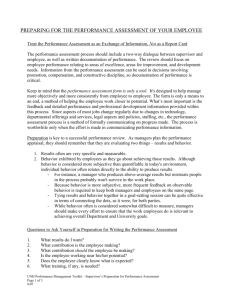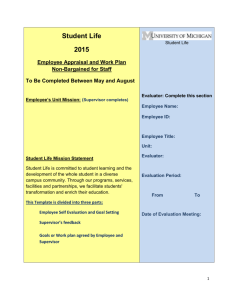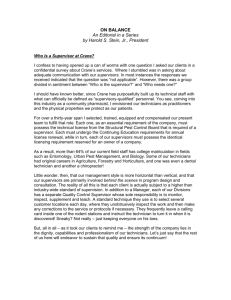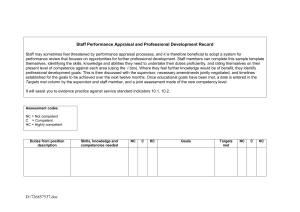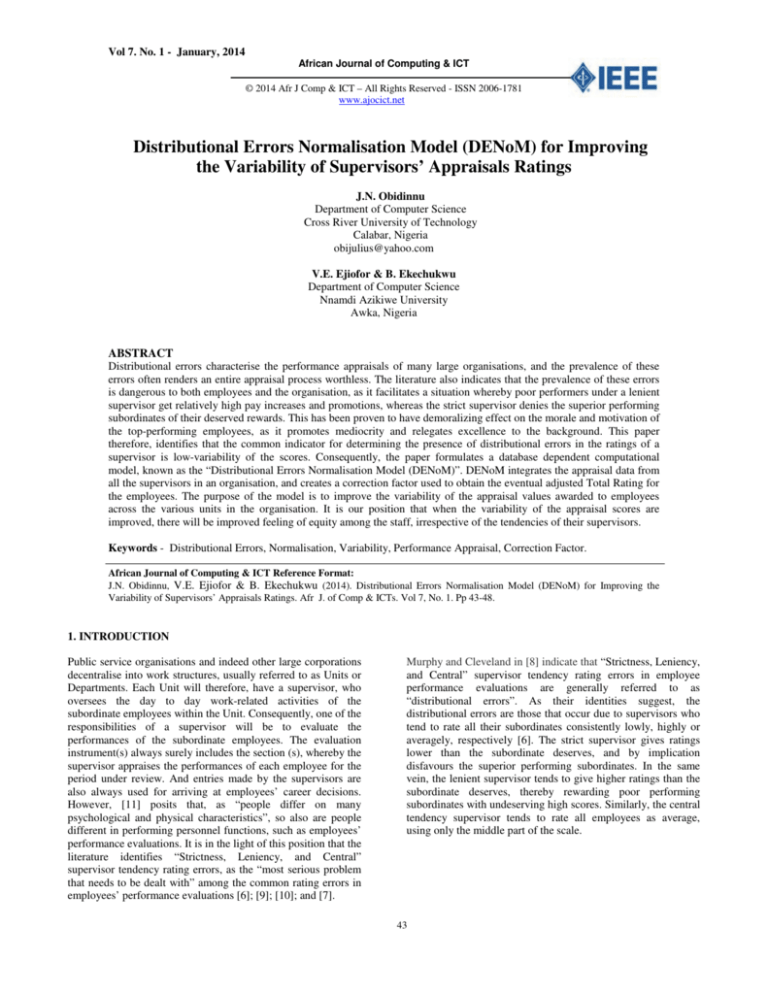
Vol 7. No. 1 - January, 2014
African Journal of Computing & ICT
© 2014 Afr J Comp & ICT – All Rights Reserved - ISSN 2006-1781
www.ajocict.net
Distributional Errors Normalisation Model (DENoM) for Improving
the Variability of Supervisors’ Appraisals Ratings
J.N. Obidinnu
Department of Computer Science
Cross River University of Technology
Calabar, Nigeria
obijulius@yahoo.com
V.E. Ejiofor & B. Ekechukwu
Department of Computer Science
Nnamdi Azikiwe University
Awka, Nigeria
ABSTRACT
Distributional errors characterise the performance appraisals of many large organisations, and the prevalence of these
errors often renders an entire appraisal process worthless. The literature also indicates that the prevalence of these errors
is dangerous to both employees and the organisation, as it facilitates a situation whereby poor performers under a lenient
supervisor get relatively high pay increases and promotions, whereas the strict supervisor denies the superior performing
subordinates of their deserved rewards. This has been proven to have demoralizing effect on the morale and motivation of
the top-performing employees, as it promotes mediocrity and relegates excellence to the background. This paper
therefore, identifies that the common indicator for determining the presence of distributional errors in the ratings of a
supervisor is low-variability of the scores. Consequently, the paper formulates a database dependent computational
model, known as the “Distributional Errors Normalisation Model (DENoM)”. DENoM integrates the appraisal data from
all the supervisors in an organisation, and creates a correction factor used to obtain the eventual adjusted Total Rating for
the employees. The purpose of the model is to improve the variability of the appraisal values awarded to employees
across the various units in the organisation. It is our position that when the variability of the appraisal scores are
improved, there will be improved feeling of equity among the staff, irrespective of the tendencies of their supervisors.
Keywords - Distributional Errors, Normalisation, Variability, Performance Appraisal, Correction Factor.
African Journal of Computing & ICT Reference Format:
J.N. Obidinnu, V.E. Ejiofor & B. Ekechukwu (2014). Distributional Errors Normalisation Model (DENoM) for Improving the
Variability of Supervisors’ Appraisals Ratings. Afr J. of Comp & ICTs. Vol 7, No. 1. Pp 43-48.
1. INTRODUCTION
Public service organisations and indeed other large corporations
decentralise into work structures, usually referred to as Units or
Departments. Each Unit will therefore, have a supervisor, who
oversees the day to day work-related activities of the
subordinate employees within the Unit. Consequently, one of the
responsibilities of a supervisor will be to evaluate the
performances of the subordinate employees. The evaluation
instrument(s) always surely includes the section (s), whereby the
supervisor appraises the performances of each employee for the
period under review. And entries made by the supervisors are
also always used for arriving at employees’ career decisions.
However, [11] posits that, as “people differ on many
psychological and physical characteristics”, so also are people
different in performing personnel functions, such as employees’
performance evaluations. It is in the light of this position that the
literature identifies “Strictness, Leniency, and Central”
supervisor tendency rating errors, as the “most serious problem
that needs to be dealt with” among the common rating errors in
employees’ performance evaluations [6]; [9]; [10]; and [7].
Murphy and Cleveland in [8] indicate that “Strictness, Leniency,
and Central” supervisor tendency rating errors in employee
performance evaluations are generally referred to as
“distributional errors”. As their identities suggest, the
distributional errors are those that occur due to supervisors who
tend to rate all their subordinates consistently lowly, highly or
averagely, respectively [6]. The strict supervisor gives ratings
lower than the subordinate deserves, and by implication
disfavours the superior performing subordinates. In the same
vein, the lenient supervisor tends to give higher ratings than the
subordinate deserves, thereby rewarding poor performing
subordinates with undeserving high scores. Similarly, the central
tendency supervisor tends to rate all employees as average,
using only the middle part of the scale.
43
Vol 7. No. 1 - January, 2014
African Journal of Computing & ICT
© 2014 Afr J Comp & ICT – All Rights Reserved - ISSN 2006-1781
www.ajocict.net
These errors characterise the performance appraisals of many
large organisations. In fact, [10] identifies the appraisal process
in public service organisations as a good example of domains
where the pervasiveness of distributional errors often renders an
entire appraisal system worthless. In support of this position, [9]
reports of a study involving 5,970 employees, where two
supervisors working with the same set of employees within the
same period, awarded inconsistent performance ratings to the
employees, such that, 62 percent of the time, employees rated
outstanding by one supervisor were rated lowly by their other
supervisor. In other words, the poor performers under a lenient
supervisor get relatively high pay increases and promotions,
whereas the strict supervisor denies the superior performing
subordinates of their deserved rewards.
DENoM is a database dependent computational model, aimed at
minimising the inequities (imbalances) occasioned by
supervisors’ appraisal tendencies. The model integrates the
appraisal data from all the supervisors in the organisation, and
creates a correction factor used to obtain the eventual adjusted
Total Rating for the employees. The purpose of the model is to
improve the variability of the appraisal values awarded to
employees across the various units in an organisation,
irrespective of the tendency of the supervisor. The testing of the
impact of this model in a real-life organisational appraisal data is
ongoing in an empirical study, and will be published in a
subsequent paper.
More so, distributional errors are also a source of problems
when an organisation wants to terminate an employee because
of poor performance, as well as when personnel decisions are
based on comparisons of appraisal ratings [10]. Consequently,
[7] asserts that the existence of these errors in performance
evaluations is dangerous to both employees and the
organisation, as it will have a demoralizing effect on the morale
and motivation of the top-performing employees. For instance, it
could get to a point where some of the superior performing
employees, working under strict supervisors decide to leave the
organisation, while some of the low performing employees
under lenient supervisors grow on the job, and probably
becoming the supervisors of tomorrow. This tendency therefore,
promotes mediocrity and relegates excellence to the background
with ominous consequences.
This paper begins with a review of the literature, aimed at
identifying the relevant issues to be addressed. This is followed
with the formulation of the Distributional Errors Normalisation
Model (DENoM). Discussions on the purpose of the model, as
well as the process of transforming appraisal data using the
model, are also presented.
Eventually, [7] posits that, “the worst situation is when a firm
has both lenient and strict supervisors and does nothing to level
the inequities”. In view of this position, this paper develops the
Distributional Errors Normalisation Model (DENoM).
2. ORGANISATION OF PAPER
3. RELATED WORKS
Murphy and Cleveland in [8] indicate that distributional errors
are thought to be present in employees’ performance appraisal
data when the plotted distribution of ratings differs from the
normal distribution of scores. And a normal distribution of
scores approximates to a bell-shaped curve, representing a
normal distribution-Gaussian curve [5]. Consequently, the
presence of distributional errors leads to a score distribution that
approximates to a curve that is tilted from the standard
distribution curve [5]. In order to make the preceding discussion
clearer, a graphical representation describing how the
distributional error curves shift from the normal distribution
curve is shown in Figure 1.
.
Figure 1: Graphical Representation of the Distributional Error Curves
Source: [5]
Other terms used to represent distributional errors are “low mean rating”, “high mean rating”, and “scale around midpoint rating” [8].
Low mean rating obtains from a strict supervisor, whereby the mean of all his ratings are substantially lower than the midpoint rating.
On the other hand, high mean rating obtains from a lenient supervisor, whereby the mean of all his ratings are substantially higher than
the midpoint rating. Similarly, the scale around midpoint supervisor follows the central tendency leaning.
44
Vol 7. No. 1 - January, 2014
African Journal of Computing & ICT
© 2014 Afr J Comp & ICT – All Rights Reserved - ISSN 2006-1781
www.ajocict.net
Variability measures, such as, standard deviation, which has
been described as “the most robust and widely used measure
of dispersion”, can be used to test their level of compliance
with standards [12]. The outcome of the testing will determine
if further action will be needed. Following this line of thought,
[8] advises that “rater error measures are the most common
indices of the accuracy of ratings”. And in support of this
position, [10] asserts that the “methods currently used to
examine the quality of ratings (i.e., detect rater errors) do so
from an aggregated perspective”. The description in the
preceding paragraph is representative of the “model-fit (or
person-fit)” approach as stated in [10].
Murphy and Cleveland in [8] indicate that, for a distribution of
performance to be true (normal), the variability of the scores
should be substantial. Variability refers to how "spread out" a
group of scores is [14]. Datasets are said to have high
variability (dispersion) when they contain values considerably
higher and lower than the mean value [14]. The literature
identifies many attempts towards substantially improving the
variability of ratings awarded by each supervisor. Some of
these attempts are presented below. Rater training to improve
the variability of ratings has been the focus of numerous
studies in employees’ performance appraisals [13].
The advocates of this approach indicate that raters’ education
will positively influence ratings through better knowledge of
key cognitive and observational demands of the rating process
[10]. However, [8] posits that the effects of applying this
recommendation depend highly on the individual tendencies
of the trained rater. While some will react positively, others
may ignore it. Furthermore, [9] reports of another approach
popularly referred to as calibration meetings.
The notion behind this approach is that rater errors are
believed to be systematic, and therefore, are detectable as
patterns in the ratings assigned by raters. Consequently, the
author further posits that, “rather than using techniques to
control errors (e.g., format, training), it may be better to utilize
methods to detect those who are committing errors and deal
with their ratings accordingly”. This paper adopts this
approach in the formulation of the model, which tests for
distributional errors in inter-Departmental employees’
performance appraisal data, and proceeds to ensure that they
conform to the normal distribution curve.
A calibration meeting involves the contribution of scores from
all the supervisors that worked with an employee within the
period under consideration. Eventually, the average of the
supervisors’ scores for each employee is considered to be
his/her eventual score. The calibration meeting exposes talent
to a much larger group of supervisors, and motivates them to
work really hard to justify the ratings awarded to their
subordinates. Its drawback, however, is the additional layer of
administration, which could hinder some of the supervisors
from doing the right things [3]. DeNisi and Griffin in [2]
indicate that the forced distribution method is another
approach being applied by many organisations to ensure that
ratings conform to variability standards. This method involves
the grouping of employees into predefined frequencies of
performance ratings. The frequencies are determined by the
organisation in advance, and are imposed on the raters.
Supervisors appraising employees under a forced-distribution
system would be required to place a certain percentage of
employees into various performance categories [4].
4. METHODOLOGY
Berry in [1] indicates that leniency, strictness, and midpoint
scaling in a set of employees’ performance evaluation data can
be determined as follows: (1) Leniency error: the resulting
mean rating score is high, the variability among scores is low,
and the scores are concentrated at the high end of the
distribution, (2) Strictness error: the resulting mean rating
score is low, the variability among scores is equally low, and
the scores are concentrated at the low end of the distribution,
(3) Central Tendency error: the resulting mean rating score is
relatively average, the variability among scores is low, and the
scores are concentrated at the middle of the distribution.
Proceeding from the above paragraph, it is sufficient to state
that the common indicator for determining the presence of
distributional errors in the ratings of a supervisor is the lowvariability of the scores that is either clustered around the top,
the middle or at the bottom.
For example, it may be required that: 10% of employees are
rated as “Excellent”, 10% as “Above Average”, 65% as
“Average”, 10% as “Below Average”, while the remaining 5%
are rated as “Poor”. This approach results in a normal
distribution of ratings. However, it has the drawback that it
may disenfranchise certain categories of staff that are actually
performing well, but could not be accommodated within the
restricted range. Nevertheless, even in the midst of applying
the aforementioned approaches, many of the supervisors still
exhibit the tendencies that introduce low variability in their
appraisal scores. Consequently, it is imperative to predetermine the variability of ratings from different raters, to
ensure that their ratings conform to the normal distribution
curve.
The focus of this paper therefore, is to introduce a model,
which will integrate the organisational appraisal data into a
central database, and produce Total Ratings with improved
variability, which is distributed among employees in the
various departments. The model is tagged “Distributional
Errors Normalisation Model (DENoM)”. The description for
deriving the model is presented below. The availability of n
units in an organisation implies that there should be n
supervisors. If a supervisor Si (i = 1, . ., n) has m subordinates
SSj (j = 1, . ., m), then the Total Score (TSi) awarded by the
Supervisor is derived, as shown in Equation 1.
45
Vol 7. No. 1 - January, 2014
African Journal of Computing & ICT
© 2014 Afr J Comp & ICT – All Rights Reserved - ISSN 2006-1781
www.ajocict.net
m
TSi awarded by supervisor Si = ∑SSj
j=1
The next stage is to determine the Correction Factor
distributive set corresponding to each of the Supervisors: Si =
{S1, S2, S3, . ., Sn}. The essence of this step is to round the
total of the NCF’s to 1, such that the final value remains a
multiple of 1. To obtain this, we take the sum of all NCF’s,
such that:
(1)
where SSj is the total score awarded to subordinate j (j = 1, . .,
m) by supervisor Si. In other words, the Total Score of a
supervisor is the sum of the totals awarded by him/her to all
the subordinates (m in number).
n
NCFi є (0,1) and ∑NCFi = 1
i=1
The next step is to determine each supervisor’s Statistical
Mean, based on the Total Score and the number subordinates.
Consequently, a supervisor’s Statistical Mean (SMi) is
derived, as shown in Equation 2.
SMi for supervisor Si = TSi
mi
In other words, take the sum of NCFi (i = 1, 2, . ., n), as in:
NCF1+NCF2+NCF3+NCF4+….+NCFn , and store the value in
a temporal variable. Then determine each Supervisor’s
Correction Factor (SCFi), by dividing each supervisor’s NCFi
by the sum of the NCF’s as previously stored in the temporal
variable. Consequently, for each supervisor Si, the SCFi is
derived as shown in Equation 8.
(2)
n
SCFi = NCFi ÷ ∑NCFi
i=1
where mi is the number of subordinates corresponding to
supervisor Si.
SCFi as computed in Equation 8 represents the Correction
Factors for the contributing supervisors Si (i = 1, 2, 3 . . . n).
Having derived the Statistical Mean for the individual
supervisors in the organisation, it becomes imperative to
determine the Organisational Statistical Mean (OSM). This is
achieved by adding all the Statistical Mean of all the
supervisors and dividing it by the number of contributing
supervisors. The computational relationship for deriving the
OSM is shown in Equation 3.
For the purpose of this study, we assign the SCFi’s to the
symbol (φ). Consequently, the Correction Factors
corresponding to the supervisors: S1, S2, S3, . . ., Sn will be: φ1,
φ2, φ3, . . ., φn respectively.
5. DISCUSSION
n
OSM =
∑SMi ÷
(8)
n
DENoM, as structured above involves several mathematical
computations. Furthermore, it requires the integration of the
databases of the submissions of the supervisors in different
units of the organisation to form a common pool of the
appraisal data. Furthermore, in very large organisations with
number of employees varying between 500 and 5000 (+), it
becomes almost impossible to accurately normalise the
Appraisal scores manually within a meaningful time-frame.
Consequently, we recommend the computerization of the
entire appraisal process in order to effectively achieve the
benefits of this model.
(3)
i= 1
where n is the number of contributing supervisors.
The next step is to determine the Non-Distributive Correction
Factor. To obtain this, each of the SMi’s will be divided by the
OSM, as shown in Equation 4.
NCF for supervisor Si = SMi for supervisor Si
OSM
4
Within a fully computerised and inter-networked system of
databases, the appraisal entries by staff and supervisors are
made through computer screens. The data transformation of
the appraisal data is achieved by dividing each employee’s
Total Score by his/her supervisor’s SCF. Preliminary results
obtained using this model indicates shows that the objectives
of developing this are achieved. The results further indicate
that the variations are proportionate to each employee’s
supervisor’s appraisal tendencies.
For instance, if there are three contributing supervisors in the
computations, then equations 5 through 7 will be
representative of their respective NCF’s.
NCF1 = SM1/OSM
(5)
NCF2 = SM2/OSM
(6)
NCF3 = SM3/OSM
(7)
46
Vol 7. No. 1 - January, 2014
African Journal of Computing & ICT
© 2014 Afr J Comp & ICT – All Rights Reserved - ISSN 2006-1781
www.ajocict.net
The values generated will usually be greater than 100. The
distributive set can also be processed, as shown earlier, in
order to adjust it to the range of 100 and below. This
Employee Adjusted Total Rating becomes the new Employee
Total Rating, which will be used in the determination of
appraisal rewards.
An extensive testing of the impact of this model in a real-life
organisational appraisal data is ongoing in an empirical study,
and will be published in a subsequent paper. In order to
determine the effect of the Correction Factor on the Employee
Total Ratings, we compare the standard deviations and the
coefficient of variation (CV) of the old and the new values.
The old value is the original Employee Total Rating before the
transformation, while the new value is the Adjusted Total
Rating.
6. CONCLUSIONS
The literature identifies Distributional errors as the “most
serious problem that needs to be dealt with” among the
common rating errors in employees’ performance evaluations
[6]; [9]; [10]; and [7]. The literature further indicates that these
errors occur due to supervisors who tend to rate all their
subordinates consistently lowly, highly or averagely,
respectively [6]. This tendency therefore, promotes mediocrity
and relegates excellence to the background with ominous
consequences.
This paper therefore, identifies that the common indicator for
determining the presence of distributional errors in the ratings
of a supervisor is low-variability of the scores. Consequently,
the paper formulates the Distributional Errors Normalisation
Model (DENoM), which integrates the appraisal data from all
the supervisors in the organisation, and creates a correction
factor used to obtain the eventual adjusted Total Rating for the
employees. The purpose of the model is to improve the
variability of the appraisal values awarded to employees
across the various units in an organisation, irrespective of the
tendency of the supervisor. And it is our position that when
variability of appraisal scores are improved, there will be
improved feeling of equity among the staff, irrespective of the
tendencies of their supervisors.
DENoM is a new approach developed in this paper for the
purposes outlined earlier. Preliminary tests results have
provided indications that the objectives of developing this
model have been achieved in a particular setting. DENom
therefore, is a contribution to knowledge.
47
Vol 7. No. 1 - January, 2014
African Journal of Computing & ICT
© 2014 Afr J Comp & ICT – All Rights Reserved - ISSN 2006-1781
www.ajocict.net
REFERENCES
[1]
[2]
[3]
[4]
[5]
[6]
[7]
[8]
[9]
[10]
[11]
[12]
Berry, L.M. (2003). Employee Selection. New York:
Thomson Wadsworth
DeNisi, A. S., Griffin, R. W. (2013). HR 2.0. Texas:
Cengage Learning
Fox, A. (2009). Curing What Ails Performance
Reviews. HRMagazine, Vol. 54, No. 1, January
2009
Ittner, C. D., Larcker, D. F. & Randall, T. (2003).
Performance Implications of Strategic Performance
Measurement in Financial Services Firms. Journal of
Accounting, Organisations and Society 28, 715–741.
Lukovac, V., Pamucar, D. & Jovanovic, V. (2012).
Assessor Distributional Errors in Evaluating
Employees’ Work Quality – Identification and
Decrease. In Proceedings of SYSMORG 2012,
Innovative Management and Business, pages 848–
853.
Lunenburg, F. C. (2012). Performance Appraisal:
Methods and Rating Errors. International Journal of
Scholarly Academic Intellectual Diversity Volume
14, Number 1, 2012.
Mondy, R. W. (2012). Human Resource
Management (12th ed). Boston: Prentice Hall. pp.
234-261
Murphy, K. R & Cleveland, J. (1995).
Understanding Performance Appraisal: Social,
Organisational, and Goal-Based Perspectives. CA:
Sage
Sammer, J. (2008). Calibrating Consistency.
HRMagazine, Vol. 53, No. 1, January 2008: 73–75.
Tamanini, K. B. (2008). Evaluating Differential
Rater Functioning in Performance Ratings: Using a
Goal-Based Approach. PhD Dissertation, Ohio
University.
United States Department of Labour (1999). Testing
and Assessment: An Employer’s Guide to Good
Practices. Retrieved January 20, 2012, from
http://www.uniformguidelines.com/testassess.pdf
University of Leicester (2013). Measures of
variability: the range, inter-quartile range and
standard
deviation.
Available
online
at:
http://www2.le.ac.uk/offices/ld/resources/numeracy/
variability
[13]
[14]
48
Woehr, D. J., & Huffcutt, A. L. (1994). Rater
training for performance appraisal: A Quantitative
Review. Journal of Occupational and Organisational
Psychology, 67, 189-205.
Yount, R. (2006). Research Design and Statistical
Analysis in Christian Ministry, 4th Edition. Texas:
NAPCE Press




